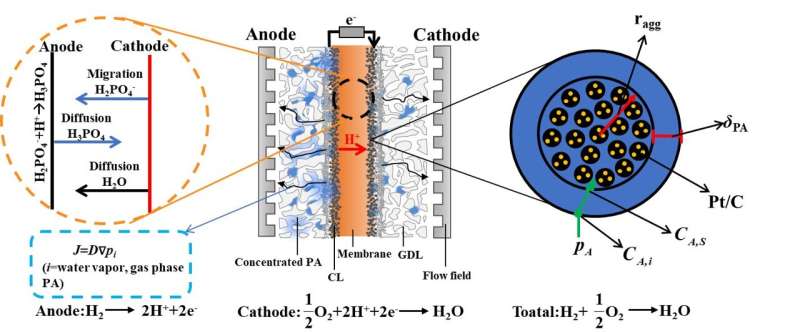
High-temperature polymer electrolyte membrane fuel cell (HT-PEMFC) can be applied in electric vehicles and marine power supplies.
However, the electrolyte in the HT-PEMFC is concentrated phosphoric acid, which migrates from the cathode to the anode during fuel cell operation, leading to phosphoric acid redistribution and thereby affecting the multiphase mass transfer and electrochemical reaction inside the fuel cell.
Recently, a research group led by Prof. Sun Gongquan and Prof. Wang Suli from the Dalian Institute of Chemical Physics (DICP) of the Chinese Academy of Sciences (CAS) developed a novel multicomponent multiphase model to predict the distribution of phosphoric acid and water in HT-PEMFC, which can help to better understand the effects of materials, structures, and operating conditions on the multiphase transport of water and phosphoric acid.
The study was published in AIChE Journal on April 9.
The researchers explored the transport mechanism of water and phosphoric acid inside the HT-PEMFC and its impact on fuel cell performance by constructing a three-dimensional, non-isothermal, multiphase HT-PEMFC model based on a catalytic layer spherical agglomerate sub-model.
This model could predict the performance of the fuel cell. It included multicomponent multiphase transport of phosphoric acid and water model, the catalytic layer spherical agglomerate model, the potential transport model, and the energy transport model.
The simulation results showed that the phosphoric acid concentration in the anode was higher than that in the cathode, and about 20% of the water generated from the cathode diffused to the anode in the form of liquid phase.
“This study provides a theoretical basis for the optimization of the design of materials, structure, and operating conditions,” said Prof. Sun.
Mu Sun et al, Investigation of phosphoric acid and water transport in the high temperature proton exchange membrane fuel cells using a multiphase model, AIChE Journal (2022). DOI: 10.1002/aic.17708
Citation:
Predicting distribution of phosphoric acid and water in high-temperature polymer electrolyte membrane fuel cell (2022, April 25)
retrieved 25 April 2022
from https://phys.org/news/2022-04-phosphoric-acid-high-temperature-polymer-electrolyte.html
This document is subject to copyright. Apart from any fair dealing for the purpose of private study or research, no
part may be reproduced without the written permission. The content is provided for information purposes only.


